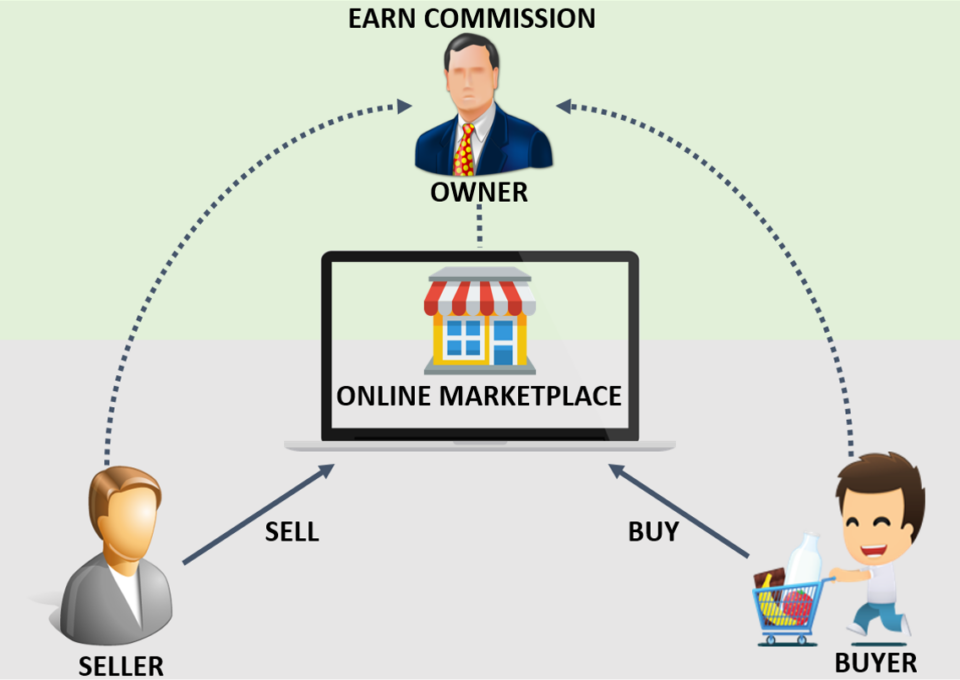
How do online marketplaces work?
An online marketplace connects a buyer and seller through a distributor’s website or application. Online marketplaces act as digital middlemen, bringing together buyers and sellers to efficiently conduct transactions. Buyers get a choice in what they would like to buy and sellers get a variety of customers to sell to. Due to the convenience that these websites offer, they have become drivers of internet economies throughout the world.
Online marketplaces have become the cash cow of online firms by driving liquidity through commissions, advertising and value-added services. Online middlemen platforms have outpaced all internet segments in terms of web traffic growth. Consumers, today, place more faith in such networks that provide a huge choice of products from both large and small retailers rather than the retailers themselves.
How do online marketplaces work?

Online marketplaces do not have to maintain inventories, logistics, images, product descriptions but can transfer this burden to the sellers. Sellers, on the other hand, get a dedicated space to manage orders and sell products. Buyers access the suppliers’ inventory electronically and the real-time information about the products being presented to the consumers is updated on a timely basis. So how do these virtual marketplaces make money? Read on to find out:
- Revenue Options
- Subscription-based model: This is one of the most popular business models. This monetization model is characterized by charging a regular fee for the supplier’s access to the platform. This revenue model helps suppliers find new clients or gain access to potential clients or partners. However, you have to ensure that your vendors get enough value to continue their subscriptions
- Sign-up fees: As the name suggests, in this model, the vendors make a flat payment when they apply to sell through your marketplace platform i.e sign up or registration fees. Since the sellers pay you upfront, no complex payment gateways are required. By emphasizing the benefits and providing early bird incentives, you can motivate vendors.
- Commission model: Here, you charge the vendor a fixed fee or a percentage as commission when they make a sale. The platform may also charge both the seller and the buyer for each conversion. Unlike subscription-based models, here the fee appears justified since the parties operate for free and pay only when they get some value from using the platform.
- Product listing fees: This marketplace business model is used commonly among two-sided marketplace platforms. In this model, you charge your vendors a flat or variable amount, when they list their products for sale. While there are a number of different ways to calculate product listing fees, you need to make it easier for the seller to pay the fees. This would encourage them to list more products.
- Mixed models: Depending upon your industry, you can choose the revenue model that suits your marketplace the most. However, you shouldn’t take a “one size fits all” approach. You can implement several models at once. By combining several models, you can have several revenue sources. Some of the major online marketplace players like Amazon have combined several models with success.
- Types of marketplaces
Marketplaces are of the following three types:
- Vertical marketplace: A vertical marketplace focuses on one particular niche. They can offer more depth and quality to their products as their sellers have greater expertise. Thus, they can increase personalization and stand out among competitors who sell everything to everyone. A good example of a vertical marketplace is Etsy. They focus on selling only handmade and vintage items.
- Horizontal marketplace: A horizontal marketplace sells a variety of goods and services. However, they all have a common secondary characteristic. You focus on one type of customer and offer them a wide variety of products or services. For eg: A marketplace for used goods.
- Global marketplace: Global marketplaces sell everything. Regardless of the distance between buyers and sellers, you’ll have an expanded inventory and buyers will have lots of options. Buying from a global marketplace is just like walking into a mall, you’ll find everything you need under one roof. eBay is the most popular example that falls in this category.
Benefits of online marketplaces

You don’t have to do it just because everyone else is doing so. Selling on an online marketplace is not beneficial for every business. However, it does have some advantages making it a good option for some businesses.
- Improved visibility: When your products are placed in a virtual high-traffic marketplace, you tend to attract more visibility. This can, in turn, drive customers to your own website or your brick and mortar store.
- Better management: If you’re a seller you don’t have to spend your time and money on developing and maintaining your own e-commerce website or app. The marketplace does it for you. You can focus on managing your merchandise rather than getting sidetracked in non-core matters.
- Low startup costs: Using online marketplaces to promote and sell goods can help small businesses to control their costs.
- Ease of use: With internet penetration increasing globally, online marketplaces provide more convenient experiences to consumers than their offline counterparts.
The future
The internet is dominated by online marketplaces who provide an ideal meeting place for buyers and sellers. With the right revenue model, you can create the ideal conditions for customers to shop and businesses to advertise.
Hybrid marketplaces offer their own products and also those from other companies. They also provide a platform for buyers and sellers to transact, thus bringing in a broader array of products. These giants give other competitors a run for their money because of their expertise, technological capabilities and virtually inexhaustible resources. To survive, marketplaces should reduce friction in both buying and selling, portray trust in all their transactions to encourage participation, offer efficiency and unique value to consumers.
Those who are unable to do so would end up losing their market share.